Chile & Argentina 2012
Chile and Argentina 2012
For years I had wanted to go to South America, but was deterred by the supposed danger in travelling around independently as I do. Several countries, including Colombia, Paraguay and Brazil are still a bit dicey, but in recent times the situation has improved and a number of countries are now considered to be reasonably safe. Peru is quite attractive, but half the people I know have been there on guided tours, so I looked for somewhere less popular
After some research on the internet I discovered that it was possible to hire in car in Santiago, Chile and drive over the highest part of the Andes to Mendoza in Argentina, which seemed quite a sensible thing to do. Chile is generally safe, and despite comparatively recent history Argentina was said to be ok for British people as long as discussion about the Falklands is avoided.
On a recent trip to Germany I had picked up a 3-year old edition of Ivanowski’s Guide to Chile, in German, for €2. It is unlikely that many British people have travelled around Chile or anywhere else using an Ivanowski guide, and it was nothing like as good as a Rough Guide or Lonely Planet, but it did have a large road map at the back. Subsequently I lashed out on a new Rough Guide (RG) which provided most of the information for my trip.
To be any good a map of Chile has to be large, because at 2700 miles from north to south it is the longest country in the world, although at its widest point it is only about 150 miles across. To put it in perspective, if you were to cut Chile out of a globe atlas and place the top end on Norway, the bottom would be on Nigeria. The capital, Santiago, is about half way down and is at the same latitude as Johannesburg in South Africa and Perth in Australia. As a consequence of the strange shape of South America the longitude of Santiago is east of that of Boston, although it is only about 70 miles from the Pacific ocean.
Despite its shape, Chile has clear cut natural boundaries, with a vast desert to the north, frozen wastes to the south, the Pacific ocean on the west and the Andes mountains on the east. This makes it impossible to generalise about the weather, but in the Santiago area I expected it to be warm in November.
There are no direct flights from England to Santiago and really it was a choice between going via Madrid, with a short flight and a very long one, or the USA with two fairly long flights. Because of the complications of immigration in the USA I decided on the Spanish route, although I was a bit concerned about the collapsing economy there. The flights were operated by Iberia in conjunction with British Airways and LAN Chile.
In the event everything went quite smoothly, although being crammed into a seat on an A340-600 for 14 hours was no great pleasure, especially as the space and in-flight services were little better than with Ryanair. Owing to a problem which my doctor describes as “common in men of your age” I had an aisle seat at the back near the toilet and had to get up at least 6 times.
Santiago
At Santiago Airport there was an excellent shared minibus system for taking people to their accommodation in the city, and it cost about £7 for 12 miles, although the traffic jams in the city centre were dreadful, practically the worst I have seen anywhere. By the time I got to my hotel I been travelling for about 30 hours.
On the way through the city we used the main thoroughfare, which has the name Avenida Libertador Bernado O’Higgins. Mr O’Higgins, who was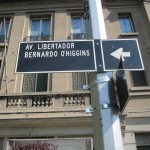 presumably of Irish extraction, figures very prominently in Chilean history as the liberator of the country in the 18th century. Many British names crop up in a similar way, examples being Walker, MacIver, Mackenna, and Cox. (Click on picture to enlarge). Av O’Higgins is very long and parts of it were lined with shabby buildings exactly as I expected South America to be. Some of the buildings had big pictures of girls all over them. It was not clear what they were but I think they might be art galleries of some sort and I resolved to go back and have a proper look at the area before leaving Chile.
presumably of Irish extraction, figures very prominently in Chilean history as the liberator of the country in the 18th century. Many British names crop up in a similar way, examples being Walker, MacIver, Mackenna, and Cox. (Click on picture to enlarge). Av O’Higgins is very long and parts of it were lined with shabby buildings exactly as I expected South America to be. Some of the buildings had big pictures of girls all over them. It was not clear what they were but I think they might be art galleries of some sort and I resolved to go back and have a proper look at the area before leaving Chile.
As usual I had booked a cheap hotel on the internet and the room was very small but clean and the people were nice. After getting sorted and resting for an hour or so I walked to Plaza des Armes, a small park which is the centre of life in the city. The hotel was in Providencia, a reasonably smart neighbourhood, and I felt quite comfortable about walking through the streets with my  backpack. On the way I called in at the car rental office, as there had been some last minute problems with the documentation for taking the car to Argentina. Over the previous few weeks I had had considerable email correspondence with a chap named Raphael, and it seemed strange to be meeting him face to face, but he said everything was ok.
backpack. On the way I called in at the car rental office, as there had been some last minute problems with the documentation for taking the car to Argentina. Over the previous few weeks I had had considerable email correspondence with a chap named Raphael, and it seemed strange to be meeting him face to face, but he said everything was ok.
The next morning I collected the car, a Nissen March (known in many countries as the Micra), and was pleased to find that it was in good condition apart from a few minor scratches. Raphael was out and the car was handed over by a pleasant Brazilian chap who said his English was not very good, and when I asked for directions to Los Andes he said “take Hooter Sink Nortay”. He repeated this several times, and it was like Basil Fawlty trying to make Manuel understand something in English, but the other way round, although this man was rather less aggressive than Basil. “Hooter Sink Nortay” was going round and round in my head, when I suddenly exclaimed “Ah! Route Five North!”. My recent attempts to learn Spanish have actually been a dismal failure but the signs to Ruta 5 Norte were easy to find and I was soon on the way to Los Andes. Once clear of Santiago there was little traffic and the road ran for a long way across an arid desert-like plain with rows of small trees as far as the eye could see. After a while I came to a toll booth, the first of many that I was to encounter in Chile. The road then climbed into the mountains via a tunnel for which another payment was demanded.
Los Andes
Eventually I arrived in Los Andes, a small town, and managed to scrounge a free map from the ‘tourist office’, a cabin at the side of the road. From the internet at home I had obtained a list of four hotels and set off in search of them with the map. The first street I tried to drive down had a man at the end in a yellow jacket taking to someone in a car, and thinking he wanted some money I squeezed past and entered the street. It was very narrow with cars both sides and I had to squiggle about to get through. After about 100 yards it was apparent that the road was blocked by a market. With great embarrassment, touching mirrors on both sides and following shouted instructions from the population of Los Andes, including the man in the yellow jacket, I reversed the unfamiliar car through the obstacle course back to the main road. The man in the yellow jacket required payment for his assistance, and I put the incident down to the SHHMS (Should Have Had More Sense) factor, which rears its ugly head somewhere on every trip.
As in many towns in Chile, the streets of Los Andes are laid out in a grid and most are one-way, which is no problem once you get used to it.
Eventually I found a decent, cheap hotel with a secure car park, which is said to be vital anywhere in South America. There certainly seems to be an obsession with security, with the iron railings and big locked gates that you see in pictures of that part of the world, but whether the crime rate is really so dreadful I don’t know. The locals warn you about walking through the streets with anything of value and the guide books tell you to keep the car doors locked and windows closed when driving around, but on the face of it it didn’t seem to me to be any worse than Portsmouth (England) and nothing like as bad as many cities in the USA.
Over the mountains
The next morning I was woken by a loud siren that I thought might be warning of an earthquake but turned out to be the way of rousing the part-time fire brigade. After breakfast I set off for Argentina, over the Andes, passing the highest mountains in the world outside the Himalayas. The road 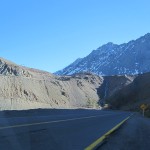 rises to an elevation of about 3500m. (11,500ft), much higher than any European pass, via a series of over 20 hairpin bends before entering a toll tunnel which cuts off the top of the original pass. The actual border between Chile and Argentina is marked by a sign inside the tunnel and a short distance after the tunnel there was a kiosk in the middle of the road with a man who shouted something in Spanish and gave me three forms. These were an immigration form for me, a form all in Spanish for the car, and a little piece of blue paper with a stamp on it. He said something about another place in “treize kilometre”, but I didn’t know whether this was 3 km or 13km. It turned out to be the main customs post, at 13km, and this was a real old style frontier checkpoint, with several lines of kiosks inside a building. There were 5 kiosks in each line, some Chilean and some Argentine, and no one spoke English.
rises to an elevation of about 3500m. (11,500ft), much higher than any European pass, via a series of over 20 hairpin bends before entering a toll tunnel which cuts off the top of the original pass. The actual border between Chile and Argentina is marked by a sign inside the tunnel and a short distance after the tunnel there was a kiosk in the middle of the road with a man who shouted something in Spanish and gave me three forms. These were an immigration form for me, a form all in Spanish for the car, and a little piece of blue paper with a stamp on it. He said something about another place in “treize kilometre”, but I didn’t know whether this was 3 km or 13km. It turned out to be the main customs post, at 13km, and this was a real old style frontier checkpoint, with several lines of kiosks inside a building. There were 5 kiosks in each line, some Chilean and some Argentine, and no one spoke English.
When I collected the car the rental people emphasised that it was vitally important to follow the correct procedure in the customs. As the temporary importer of the vehicle into Argentina it was my responsibility to ensure that the correct papers were stamped and I must be with the car on its return to Chile, otherwise I would be liable for duty in excess of its value. If it got smashed up in Argentina I had to come through the frontier with the wreckage on a breakdown truck. They omitted to say what would happen if I got smashed up.
In the customs shed my passport, the wad of papers I had for the car and the ones that I had been given by the man a few miles back were all taken and stamped, stamped, and stamped again. A young chap appeared who spoke a little bit of English and asked me for ” the paper with the blue light”, by which I assumed that he meant the little bit of blue paper, which had fallen down between the seats. This seemed to be the most important of the lot, and by the time I finally escaped it was completely covered with stamps.
A few miles further on I was stopped yet again by a man standing in the middle of the road who took the little piece of blue paper, folded it, and put it in a slot in the top of a box. It is impossible to understand the purpose of this arrangement, but I drove away feeling that I might somehow have voted for the next President of Argentina.
Argentina
The mountains on the Chilean side were plain and not very attractive, but on the Argentine side they were altogether more colourful. Although the road on the descent from the pass was comparatively straight the scenery was superb with little traffic. There were several places of interest that I resolved to look at on the way back, and I pushed on to a small town called Uspalatta, where I stopped for a look round. It was immediately obvious that Argentina was less prosperous than Chile, the place having a general run down appearance with many tatty old cars driving about. Only the few main streets were tarmacked, the rest being compacted soil.
road on the descent from the pass was comparatively straight the scenery was superb with little traffic. There were several places of interest that I resolved to look at on the way back, and I pushed on to a small town called Uspalatta, where I stopped for a look round. It was immediately obvious that Argentina was less prosperous than Chile, the place having a general run down appearance with many tatty old cars driving about. Only the few main streets were tarmacked, the rest being compacted soil.
On to Mendoza, which is the second largest city in Argentina. If you are a wine lover you will definitely have heard of it, but it was unknown to me until I planned this trip. It is quite large, population over 110,000, but I quickly found a reasonable hotel within walking distance of the centre, booked for two nights and went to explore.
Mendoza is a totally planned city, after being completely destroyed by an earthquake in 1861. It was rebuilt with wide tree-lined streets, but those I walked through into town were quite shabby with a lot of closed business premises. The pavements were in very poor condition, with large holes and open drainage channels everywhere, and you have to keep an eye on the ground at every step you take. The streets appear to be designed to cope with vast quantities of water, and I can only assume that when it rains it must do so in a big way.
tree-lined streets, but those I walked through into town were quite shabby with a lot of closed business premises. The pavements were in very poor condition, with large holes and open drainage channels everywhere, and you have to keep an eye on the ground at every step you take. The streets appear to be designed to cope with vast quantities of water, and I can only assume that when it rains it must do so in a big way.
The centre is smarter, with shopping streets based around a beautiful large park with four smaller parks nearby, and in contrast to the suburbs there was plenty going on. The main streets were very European in character, with lots of old French and Italian cars, plus a few British ones from the 1960s through to the 80s. Mr.O’Higgins was apparently also in 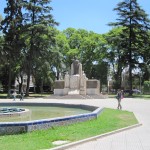 action here, his name having been given to a park. Like Santiago, Mendoza has a good road system, but again, without local knowledge you can easily get into a mess, as I did when drove down to a big modern shopping mall in the evening.
action here, his name having been given to a park. Like Santiago, Mendoza has a good road system, but again, without local knowledge you can easily get into a mess, as I did when drove down to a big modern shopping mall in the evening.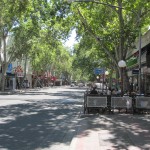
Within my lifetime Britain has fought in or against many countries around the world, Argentina being one of the more recent ones. In the period leading up to this trip there were rumblings about the Falklands (or Malvinas if you are on the other side) again and I was not sure how I would be received. In the event I did not sense any hostility from anyone, and the only reference to the subject I came across was a properly made notice at the roadside shortly before the border tunnel that appeared to say MALVINAS FOR ARGENTINA. On one of the main streets in Mendoza there was an old-style British red telephone kiosk with a working phone in it and intact windows, which suggests that in this area, at least, there cannot be any ill feeling.
 On the Sunday when I drove from Los Andes to Mendoza there was little traffic on the road, but for the first 20 miles when I left on the Tuesday morning to go back over the mountains I was dicing with death trying to get past an endless string of slow trucks. Fortunately most of them turned off into an industrial area leaving a fairly clear road to the border. A few miles before the border is a famous place called Puerte del Inca (Bridge of the Incas), which is a natural stone bridge over a river with a high concentration of minerals, so that objects left in it for a long time become “petrified”, acquiring a hard bright yellow coating of rock-like material. Many such items are offered for sale along with the usual tourist tat.
On the Sunday when I drove from Los Andes to Mendoza there was little traffic on the road, but for the first 20 miles when I left on the Tuesday morning to go back over the mountains I was dicing with death trying to get past an endless string of slow trucks. Fortunately most of them turned off into an industrial area leaving a fairly clear road to the border. A few miles before the border is a famous place called Puerte del Inca (Bridge of the Incas), which is a natural stone bridge over a river with a high concentration of minerals, so that objects left in it for a long time become “petrified”, acquiring a hard bright yellow coating of rock-like material. Many such items are offered for sale along with the usual tourist tat.
Also at Puerto del Inca are the remains of the former narrow gauge railway from Los Andes to Mendoza, originally built with the help of British engineers. It was abandoned in 1989, and bits and pieces of it can be seen alongside the road on both sides of the border. This is the main land route between Chile and Argentina, and In 2009 it was decided that a new railway would be built, but bearing in mind the surprisingly low amount of traffic on the road it is hard to see how the vast cost could be justified.
with the help of British engineers. It was abandoned in 1989, and bits and pieces of it can be seen alongside the road on both sides of the border. This is the main land route between Chile and Argentina, and In 2009 it was decided that a new railway would be built, but bearing in mind the surprisingly low amount of traffic on the road it is hard to see how the vast cost could be justified.
It was vital for me to get the car papers stamped before leaving Argentina, but it was not clear how to do that, because the customs post that I had been through before was only for traffic going the other way, and there was nowhere else before the tunnel. Eventually I found a young priest in the customs queue for Argentina who spoke quite good English, and he explained that there were Argentine officers in the customs on the Chile side of the tunnel.
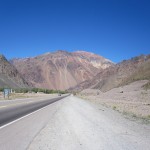 About the only similarity between the two customs posts was that no one spoke English on the Chilean side either, and I was led from window to window, queue to queue, desperately trying to hang on to all my pieces of paper. Every time I thought it was all over another obstacle would appear. Next time I will bring my own rubber stamp, because I think it is a bit like Russia - as long as you have enough pieces of paper with stamps it doesn’t matter what is on them.
About the only similarity between the two customs posts was that no one spoke English on the Chilean side either, and I was led from window to window, queue to queue, desperately trying to hang on to all my pieces of paper. Every time I thought it was all over another obstacle would appear. Next time I will bring my own rubber stamp, because I think it is a bit like Russia - as long as you have enough pieces of paper with stamps it doesn’t matter what is on them.
Eventually I managed to escape and after a couple of hundred yards turned off the road into Portillo, described by the RG as an upmarket ski resort. For me this would be the Ski Resort from Hell, consisting of what appeared to be a brightly coloured pre-fabricated accommodation block and some big blue sheds. The skiing is undoubtedly good, because of the altitude, but limited in scope compared with European resorts and completely lacking in Alpine character.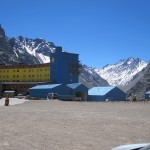
The first two days in Chile had been pleasantly warm, but when I got back to Los Andes it was scorching hot, I would estimate about 90deg. I had reserved a room in the same hotel as before, and the lady owner seemed quite pleased to see me.
To the Pacific coast
Originally I planned to drive across country to the coast, but the route was not very inspiring so I decided to go back via Santiago and call into the car rental office to make sure that the papers were in order and give them time to sort things out if they were not. This would have been a good idea if I had a decent map of Santiago, but within a short time of entering the city I was hopelessly lost. By now I realised that the city was very much larger than I thought. With a remarkable piece of luck I found two men polishing second hand cars in front of a place called Royal Cars, and they both spoke good English. They set me on the right track, but it took 10 minutes driving at 60 mph on an urban motorway to bring me close to the car rental place, which gives some idea of the size of the city.
Everything was ok with the papers so I set off for the coast, aiming for a resort called Viña del Mar, near Valparaiso. On the way I departed from the motorway a couple of times to go into the mountains. At the first attempt I ended up on a concrete road that was only wide enough for one vehicle, 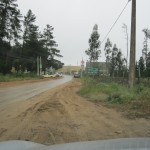 with a strip of bumpy sand 2 or 3 inches lower on each side so every time something came the other way (and there was a lot of traffic) I had 2 wheels on the concrete and 2 wheels on the sand, at one stage doing about 30mph with a bus a few feet behind. There are a tremendous number of little buses everywhere, mostly Mercedes-based and quite old. They seem to be very tough and can take this sort of treatment in their stride, which my car could not.
with a strip of bumpy sand 2 or 3 inches lower on each side so every time something came the other way (and there was a lot of traffic) I had 2 wheels on the concrete and 2 wheels on the sand, at one stage doing about 30mph with a bus a few feet behind. There are a tremendous number of little buses everywhere, mostly Mercedes-based and quite old. They seem to be very tough and can take this sort of treatment in their stride, which my car could not.
There was also a marvellous stretch of mountain road with lots of hairpin bends, sheer drops and trucks coming the other way. This road was not too badly surfaced, but once you deviate from the main highway it is common to find stretches of dirt, sand or gravel.. 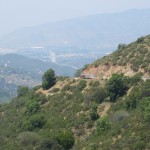
The first thing I noticed on entering Viña del Mar was the number of stray dogs running around, almost like Romania. The town was a bit of a disappointment, with terrible traffic and seemingly no hotels of the sort I was looking for, so I decided to try Reñaca, a couple of miles further north. According to the RG, Reñaca is a lively upmarket resort, but overpriced. The guide was wrong on the first two counts but right on the third. The place was like Bognor Regis on a bad day in the winter, with the sea front all messed up by road works, but I got a very expensive room overlooking the ocean, or as much of it as was visible through the mass of electrical cables and junction boxes.in front of the window.
 I had seen the Pacific a few times before (in California) but never stayed close to it, and I was amazed at how noisy it was. For years I have lived in a beach house on the English Channel and am used to the sound of a rough sea, but the breaking waves of the Pacific seemed to be a whole order of magnitude louder, even though there was no wind. Just as I arrived some surfers were packing up for the day, and although the breakers were very wide they did not look exceptionally high.
I had seen the Pacific a few times before (in California) but never stayed close to it, and I was amazed at how noisy it was. For years I have lived in a beach house on the English Channel and am used to the sound of a rough sea, but the breaking waves of the Pacific seemed to be a whole order of magnitude louder, even though there was no wind. Just as I arrived some surfers were packing up for the day, and although the breakers were very wide they did not look exceptionally high.
Valparaiso
Next on the list was Valparaiso, or Valpo as it is known to blasé world travellers such as myself. After the fiasco with the hotel in Reñaca I went on the internet and lined up three cheap hotels in Valpo with secure parking, using the maps in the local phone book, but did not make a reservation because the internet connection was public.
Valpo is an extraordinary place, with the centre more or less at sea level and the rest of the town rising up steeply behind it. It has a big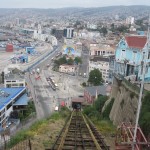 container port, and the guide books warn about the danger of walking at night or alone in the port area. The hillside above the town is covered with densely-packed brightly coloured houses, mostly built on stilts to compensate for the steep slope. Many are in poor condition and give the appearance of a shanty town when seen from a distance. Some parts of Valpo on the higher ground are laid out in a grid, but the roads leading up from the main town take a tortuous route with hairpin bends through narrow streets.
container port, and the guide books warn about the danger of walking at night or alone in the port area. The hillside above the town is covered with densely-packed brightly coloured houses, mostly built on stilts to compensate for the steep slope. Many are in poor condition and give the appearance of a shanty town when seen from a distance. Some parts of Valpo on the higher ground are laid out in a grid, but the roads leading up from the main town take a tortuous route with hairpin bends through narrow streets.
The previous evening I had studied the telephone directory maps very thoroughly and had a good idea of the way to the three hotels I was looking at, which were quite close together near the top of the hill above the harbour. At the quaintly named Plaza Wheelwright (presumably another British pioneer) I turned off left onto the steep climb, followed by several taxis, which started sounding their horns after a while because I was not going fast enough. Not fast enough for them, that is, I was going quite fast enough for me. As the road went uphill the character of the neighbourhood went the other way, becoming the sort of area where I would not really want to stop or get  out of the car.
out of the car.
The first hotel was in a street called Levarte, and although it was slightly better than some of what I had come through it did not exactly come across as salubrious. Driving slowly along the street I realised that there was one building that was much smarter than the others, a single storey Spanish style house with a forecourt behind the obligatory iron railings and gates. This was the Hospedaje Familiar El Mirador Bed & Breakfast, and turned out to be absolutely brilliant. It was run by a lady and her daughter, and was like a comfortable Spanish family house with self-catering apartments behind it. The price was exactly half that of the awful place in Reñaca.
Parking in the centre of Valpo is practically impossible, so I decided to walk into the town. The ladies told me take nothing of value with me, including my passport, which they said I should put in the room safe. This was a tiny steel box bolted to the wall, and had an electronic system for setting up the combination number, which I knew from past experience was difficult enough if the instructions were in English, and here they were only in Spanish. In any case it never seems very sensible to me to leave valuables in a place where everyone would expect to find them, and safes like that are only as good as the wall they are fixed to, which in this case would probably not amount to much.
setting up the combination number, which I knew from past experience was difficult enough if the instructions were in English, and here they were only in Spanish. In any case it never seems very sensible to me to leave valuables in a place where everyone would expect to find them, and safes like that are only as good as the wall they are fixed to, which in this case would probably not amount to much.
In the end I hid my passport in the locked car in the locked car park and put one credit card under the insole of one of my shoes, as well as some other security measures. The ladies gave me a bunch of six keys, with instructions not to lose them, so that I could get to and from my room, and also a map marked with all the local sights.
It was a walk of about a half mile down the hill to the port area, including a long, graffiti –covered flight of steps between derelict graffiti-covered  buildings. There is graffiti everywhere, some of it quite artistic I suppose, but who is to say what is artistic nowadays? There was hardly anybody around and it was not an environment to inspire a feeling of security, but I tried to look as if I belonged there and knew where I was going. It would probably have been more convincing if I had been holding a can of aerosol paint.
buildings. There is graffiti everywhere, some of it quite artistic I suppose, but who is to say what is artistic nowadays? There was hardly anybody around and it was not an environment to inspire a feeling of security, but I tried to look as if I belonged there and knew where I was going. It would probably have been more convincing if I had been holding a can of aerosol paint.
The port area and centre of Valpo really were South America as I had hoped to find it, with narrow streets, rough old buses and trolley buses, and buildings ranging from smart to dilapidated, mostly the latter. Some of the more imposing buildings and monuments were connected to the city’s naval heritage, and there were a fair number of seamen around.
 The central area is long and narrow, just a few blocks wide, with several plazas and small parks. At intervals there are long flights of steps leading up the hill and ancient cable operated lifts with wooden cabins holding about 12 people in each direction. The RG recommended trying these to experience the view from the top, and said that “despite their rickety frames and alarming noises they’ve so far proved safe and reliable”. I tried one called the Ascensor Concepción, built in 1883, and was pleased to find that the “so far” held out. The view from the top was worth it, but I had to walk down to avoid a half hour queue.
The central area is long and narrow, just a few blocks wide, with several plazas and small parks. At intervals there are long flights of steps leading up the hill and ancient cable operated lifts with wooden cabins holding about 12 people in each direction. The RG recommended trying these to experience the view from the top, and said that “despite their rickety frames and alarming noises they’ve so far proved safe and reliable”. I tried one called the Ascensor Concepción, built in 1883, and was pleased to find that the “so far” held out. The view from the top was worth it, but I had to walk down to avoid a half hour queue.
On the way back to the hotel I stopped for a rest in Plaza Echaurren, city’s oldest square, described in the RG as “very picturesque save for the wine-swilling characters who permanently occupy its benches”. Despite not swilling any wine I felt quite at home there. A friend often says I go around dressed like an extra from ‘On The Waterfront’, which is probably not a bad thing in such places. Nearby was another  funicular lift, Ascensor Artilleria, which took me up the steepest bit of the climb back to my hotel and avoided an unsavoury part of the route.
funicular lift, Ascensor Artilleria, which took me up the steepest bit of the climb back to my hotel and avoided an unsavoury part of the route.
At about 9pm I ventured out of the hotel and walked down Levarte to some small shops. These were like the back street shops I remember in England from my childhood, the small, dark front rooms of houses, although there was one bright one, which seemed to be a lottery-based betting shop. Back at the hotel, a veranda near my apartment afforded a magnificent view across the city, with all its coloured lights.
The coast.
The next morning I set off to explore the Pacific coast travelling south round a headland high above the ocean, and immediately ran into heavy mist, causing the car to fog up in a big way. The day before I noticed that the houses high on the hill were in low cloud, and from road signs warning of fog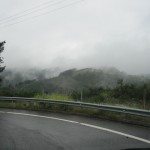 it appeared that this was a frequent occurrence.
it appeared that this was a frequent occurrence.
The first place on my itinerary was to be a coastal village called Quintay which could only be reached by driving inland for some distance and taking a mountain road. It was quite a scenic drive and eventually I came to what appeared to be the main street of Quintay, consisting of a short length of dual carriageway with a dirt surface between two lines of bungalows. At this point I suddenly realised that I was low on fuel, with 2 bars showing out of 10 on the gauge, and I had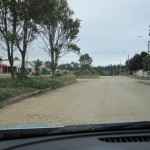 no idea how far how I could get on that. There was a small shop half way along the street, so I went in, looked at the lady behind the counter and said “Gasolina?”. I knew it was called that because it said so on a Dymo-Tape sticker on the dashboard to prevent misfuelling. She took me outside, pointed diagonally across the street and said something about ‘five litres’. There was no sign of any petrol pumps where she had indicated, so I drove back to the tarmac road and turned downhill towards the ocean. Half way down there was a man loading something into a white pick-up, and when I asked him about gasolina he indicated that I should follow him. We stopped in front of a bungalow in exactly the place that the shopkeeper had said, and he shouted something, whereupon a lady appeared from behind the building. At this point I noticed a rough piece of wood on the fence with “LINA” scrawled on it, so this was the filling station.
no idea how far how I could get on that. There was a small shop half way along the street, so I went in, looked at the lady behind the counter and said “Gasolina?”. I knew it was called that because it said so on a Dymo-Tape sticker on the dashboard to prevent misfuelling. She took me outside, pointed diagonally across the street and said something about ‘five litres’. There was no sign of any petrol pumps where she had indicated, so I drove back to the tarmac road and turned downhill towards the ocean. Half way down there was a man loading something into a white pick-up, and when I asked him about gasolina he indicated that I should follow him. We stopped in front of a bungalow in exactly the place that the shopkeeper had said, and he shouted something, whereupon a lady appeared from behind the building. At this point I noticed a rough piece of wood on the fence with “LINA” scrawled on it, so this was the filling station.
The lady produced a five-litre clear plastic container full of a pale yellow liquid, and a funnel with a long tube attached. The whole set-up was spotlessly clean. She put the fuel in the car and charged me the equivalent of £8, the highest price I have ever paid for five litres of petrol, but it was 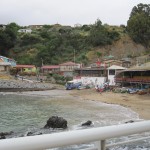 a captive market and my fault for not watching the petrol gauge. The normal price for petrol in Chile is about £1.15 per litre, so the lady was, as they say, onto a ‘nice little earner’.
a captive market and my fault for not watching the petrol gauge. The normal price for petrol in Chile is about £1.15 per litre, so the lady was, as they say, onto a ‘nice little earner’.
Back to the coast road, and this led to a bay with a pretty little fishing port, but, like Reñaca, it was still out of season and everything was closed. Pushing on south, the road ran through a series of coastal resorts, with names like Algarrabo, El Quisco, El Tabo. Some had nice beaches and I stopped here and there for a walk around.
Looking at the map, the most sensible place to spend the night appeared to be San Antonio, but I changed my mind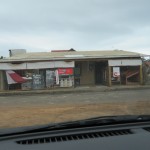 when I got there. It was a rough port town, and the first impression was it was not a good place to stop at all, let alone for the night. There seemed to be only one hotel, combined with a casino, and after failing to find another hotel on a drive right round the town on the back roads I decided to move on to somewhere else.
when I got there. It was a rough port town, and the first impression was it was not a good place to stop at all, let alone for the night. There seemed to be only one hotel, combined with a casino, and after failing to find another hotel on a drive right round the town on the back roads I decided to move on to somewhere else.
The next town, about five miles away, separated from San Antonio by a long bridge over the Rio Maipo estuary had the grand name of Rocas de Santo Domingo, and was as grand as its name. It was unbelievably different from San Antonio, like an upmarket private estate with big detached houses. There was a sign to a hotel that turned out to be as smart as the rest of the place, with a separate restaurant/reception building and the accommodation in chalets amongst the trees. In the car park there was one car which obviously belonged to someone who could not afford to be a paying guest, and I quickly discovered that I was also in that category. Anyway, the place was deserted and it would be like staying in a chapel of rest.
Back to Santiago
The next day I had to be in Santiago, so there was little choice of route from Santo Domingo, and the only likely place for a hotel was a town called Melipilla, about 50 miles away. On entering Melipilla it was San Antonio all over again, the sort of area where everybody looked like extras from ‘On The Waterfront’, even though it was not a port. I pulled on the forecourt of a service station and stopped in front of the office. As I got out of the car a man came out of the office and shouted at me. He was the toughest, hardest looking character I have ever seen, let alone met. He was a bit taller than me but about twice as wide, with a big ugly face, swarthy complexion and a scar on his chin where a knife had been jabbed into it. This man was hard, real hard, fifty per cent harder than the two Mitchell brothers put together, but instead of killing me he pointed out that I had left my headlights on.
I looked at him and said optimistically, “Hotel?”. He put his hand on my shoulder, guided me to the edge of the forecourt and explained very carefully three times in Spanish that there was a hotel on the left hand side of the third road on the left. He then walked back to the car with me, shook my hand and went into the office. At least I know where to find a bodyguard if ever I want one.
The hotel was excellent, obviously catering mainly for business people because I cannot imagine many tourists visiting Melipilla. With some trepidation I decided to go out and have a look at the area and find something to eat. The main road really was seedy, with a lot of scruffy car repair workshops, some closing for the evening, and a fair number of dubious- looking characters just hanging about. In this situation you always want to take photographs but it is unwise unless you have a concealed camera.
The first eating place I came to looked like a proper restaurant, but in fact only did “sandwiches”, like a vast number of places in Chile. The sandwiches consisted of large round bread rolls with an exciting choice of fillings - ham or cheese. I chose the former, with a fizzy drink. Unsurprisingly this was not really enough, and rather than continue the hazardous walk towards the centre of Melipilla in the hope of finding a better restaurant I got some stuff from a small supermarket and took it back to the hotel. This will be a good example to put in the “Travellers’ Guide to Fine Living”, when I get round to writing it.
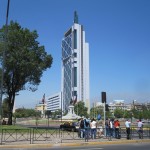 It was about 50 miles to Santiago, and the next morning I wanted to take the car back to the rental office, check in at my hotel, and spend the rest of the day looking round the city. Needless to say, I got lost yet again on the autopista in the suburbs, adding at least 20 miles to the journey and paying one toll twice, but I saw quite a lot of the outskirts in the process.
It was about 50 miles to Santiago, and the next morning I wanted to take the car back to the rental office, check in at my hotel, and spend the rest of the day looking round the city. Needless to say, I got lost yet again on the autopista in the suburbs, adding at least 20 miles to the journey and paying one toll twice, but I saw quite a lot of the outskirts in the process.
The car rental people were extremely fair, actually reducing the charge because I had returned the car 22 hours early. Overall, I had found both Chile and Argentina to be very “straight” countries in this sort of way, with no one trying to make a quick buck at every opportunity.
To give me more time in the central area I took the crowded underground train from near my hotel to Avenida Bernado O’Higgins, holding my backpack in front of me, and it didn’t seem any different from the underground in any other capital city.
Santiago hasn’t actually got a lot of “sights”, but I photographed a few streets, buildings and monuments. There were certain areas in the main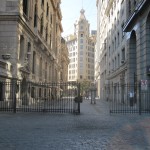 streets with signs saying that photography was not allowed, although I could not see why. In this day and age, when so many people have camera phones, it is ridiculous anyway. There were police around in cars, on foot, as well as on motorcycles and scooters, but not to the point where it felt anything like a police state, which it certainly was from 1973 to 1988.
streets with signs saying that photography was not allowed, although I could not see why. In this day and age, when so many people have camera phones, it is ridiculous anyway. There were police around in cars, on foot, as well as on motorcycles and scooters, but not to the point where it felt anything like a police state, which it certainly was from 1973 to 1988.
A strange thing that I noticed in all Chilean towns was the extraordinary number of dispensing pharmacies, with staff smartly kitted out in white uniforms. The general health of the population appears to be quite good, and it is difficult to understand how all these businesses can be viable. Second to pharmacies were hardware shops. Macdonalds and Burger King were also there in strength.
There was far less German influence than I expected, with few recent BMWs or Mercedes on the roads, but a lot of VW products from Brazil. Most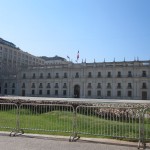 new cars and small trucks are from the Pacific rim, and increasingly, China.
new cars and small trucks are from the Pacific rim, and increasingly, China.
Despite the rough bits, overall I liked Chile and Argentina. The people were generally pleasant and honest, and then was none of the in-your-face hassle found in some other countries, but the language was a bigger problem than I expected. When I was waiting at the airport for my flight home I was interviewed by a lady from the Government Tourist Office, and she said although English is the second language it is not very well taught and few pupils leaving school can actually speak it. It is hard for us to complain about this, because how many British children come out of school able to speak a foreign language?
Another matter she asked me about was the cost, both of getting to Chile and when I was there. In both cases I said it was high, and she said Chile is the most expensive country in South America.
Perhaps the biggest unanswered question is the matter of safety and security on the streets. As mentioned above, the locals everywhere seem to think the country is crime-ridden and take what might seem to many West Europeans to be extreme precautions. The area around my hotel gave the impression of being quite safe, but no one was allowed into the hotel without being scrutinised. There was a parking regime in the nearby streets with marked spaces and signs stating the charges. During the day a man with a yellow jacket sat at a junction within sight of the spaces to collect the money and act as security. As soon as he went home the cars disappeared and very few were left on the street at night. The Chinese vehicle dealership in the next road cleared the open forecourt at closing time and put everything into a secure compound at the back.
On a completely different tack, there were lots of birds around but not many insects anywhere. Even in the 90 degree heat of Los Andes and the damp of Valparaiso all I saw were a few flies In 800 miles I only had to clean the car windscreen once. The books warned about a disease-bearing mosquito, so I took plenty of DEET insect repellent, but did not need it.
Chile and Argentina are vast countries, and in the nine days that I was there I saw just a tiny, but significant, part of them. Other parts are undoubtedly very different, with wild landscapes and extremes of climate, but a wider exploration would be demanding in both time and cost.